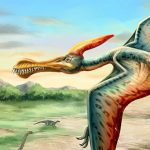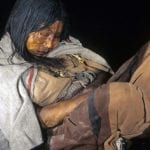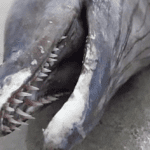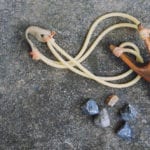 Mysteries
Mysteries  Mysteries
Mysteries  History
History 10 Surprising Stories About the Texas Rangers
 Humans
Humans 10 Philosophers Who Were Driven Mad by Their Own Theories
 Miscellaneous
Miscellaneous 10 Video-Game-Worthy Weapons and Armors from History
 Weird Stuff
Weird Stuff 10 Psychics Who Accurately Predicted Wartime Events
 The Arts
The Arts 10 Pieces of Art Inspired by a Broken Heart
 Health
Health 10 Science Fiction-Sounding New Medical Treatments
 History
History 10 Surprising Facts About the Father of Submarine Warfare
 Space
Space Ten Astonishing New Insights into Alien Worlds
 Weird Stuff
Weird Stuff 10 Bizarre Summer Solstice Rituals Still Practiced Today
 Mysteries
Mysteries Top 10 Haunting Facts About the Ghost Ship MV Alta
 History
History 10 Surprising Stories About the Texas Rangers
 Humans
Humans 10 Philosophers Who Were Driven Mad by Their Own Theories
Who's Behind Listverse?

Jamie Frater
Head Editor
Jamie founded Listverse due to an insatiable desire to share fascinating, obscure, and bizarre facts. He has been a guest speaker on numerous national radio and television stations and is a five time published author.
More About Us Miscellaneous
Miscellaneous 10 Video-Game-Worthy Weapons and Armors from History
 Weird Stuff
Weird Stuff 10 Psychics Who Accurately Predicted Wartime Events
 The Arts
The Arts 10 Pieces of Art Inspired by a Broken Heart
 Health
Health 10 Science Fiction-Sounding New Medical Treatments
 History
History 10 Surprising Facts About the Father of Submarine Warfare
 Space
Space Ten Astonishing New Insights into Alien Worlds
 Weird Stuff
Weird Stuff 10 Bizarre Summer Solstice Rituals Still Practiced Today
10 Fantastic Fossils Found by Accident
Paleontologists typically study for years to get their master’s degree or Ph.D. in paleontology. This extensive academic background enables them to start a career searching for and studying ancient animal and plant fossils. It’s exciting work that also explores the relationship between ancient living things and their modern-day relatives.
So it’s always big news when paleontologists discover a fossil that provides new information about dinosaurs, mammoths, or a whole new species we have never known about before.
But sometimes, these experts are bested by a chance discovery. They may search for a specific fossil for years, only for someone to take a leisurely walk on a beach and stumble across that very fossilized trace of an unknown species. This list details some of the most fantastic fossils found completely by accident in recent years.
Related: 10 Fascinating Things Rare Fossils Recently Taught Scientists
10/span> Mammoth Fossils Found during Construction Work
In 2016, workers installing a new drainpipe just outside Mexico City made a massive discovery. As they dug into the road, their tools hit the remains of a 14,000-year-old mammoth that weighed around 10 tons (9 tonnes) when it was alive. A paleontologist called to the scene announced that the mammoth had most likely been cut to pieces after its death based on how its bones had been scattered 6 feet (1.8 meters) below the surface.
In 2019, residents of the state of Puebla discovered a mammoth tusk alongside an ancient wolf fang and a camel skull. Considering that the wolf would have hunted camels and mammoths, experts were perplexed as to why their remains would be located in one spot.
The discovery of ancient weapons close to the animal remains provided an answer, however. The giant animals were likely killed by humans and simply left on a heap to decompose.
In 2020, archaeologists finally had their chance to aim a spotlight at their profession when they discovered around 200 mammoth skeletons beneath a construction site in Mexico. The site was being developed into an airport when huge mammoth traps and fossils were found.[1]
9 Giant Millipede Fossil Found on a Beach
If you’re not a fan of giant bugs, you likely won’t want to imagine an 8-foot-long (2.5-meter), 110-pound (50-kilogram) millipede crawling toward you on the beach. One hundred million years before dinosaurs roamed the planet, these gigantic millipedes were the biggest bugs to walk on land. They are believed to have feasted not only on nuts and seeds but also on small animals to keep up their impressive weight.
In 2021, UK scientists revealed that they’d discovered by chance the fossilized remains of a massive millipede at Howick Bay, Northumberland, England.
The group of scientists had been visiting the beach to study its geology when they happened upon a boulder that had broken loose from a cliff and split in half. When they approached the rock, they saw the fossil inside the crack that had formed when it fell.
At that point, the millipede (Arthropleura) fossil was only the third to be discovered and the first in England.[2]
8 200 Million-Year-Old Dinosaur Bone Found in Rubble
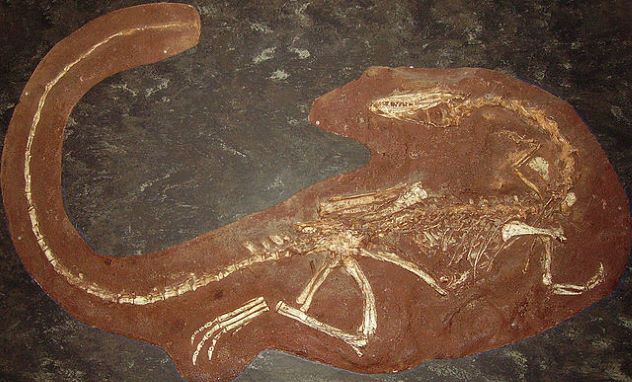
In August 2021, geology professor Mark McMenamin was taking a walk on the University of Massachusetts Amherst campus. He strolled past a group of construction workers and saw a pile of loose rocks close to where they were working. He asked if he could take some of the rocks home to add to his wife’s garden, and when the workers agreed, McMenamin collected around 20 stones he thought would work well.
When he arrived home and inspected the stones, Professor McMenamin noticed that the rough texture of one of the rocks resembled that of a fossil. He tested it using X-ray technology and, to his amazement, discovered that the rock contained the elbow bone of a neotheropod.
Neotheropods were large dinosaurs that lived during the Early Jurassic Period, characterized by their sharp teeth and hollow bones. McMenamin studied his discovery and surmised that the dinosaur fed on freshwater fish and may have lived exclusively in the water. Neotheropods existed before the T. Rex and were the largest predatory dinosaurs of their time.[3]
7 Boy Trips Over Stegomastodon Fossil
In 2017, 9-year-old Jude Sparks literally stumbled over an object that turned out to be one of the most exciting fossil finds in recent years.
Jude was hiking with his family in the Organ Mountains of New Mexico when he tripped and fell over something he initially thought was the remains of a cow. When his parents took a closer look, they realized it couldn’t be cow bones, and the more they all stared at the object, the more convinced they became that they’d found something special.
Jude’s parents contacted a professor from New Mexico State University, who examined their find and concluded that the boy had tripped over a fossilized Stegomastodon tusk. The Sparks family was amazed at this information and began a fundraiser to help pay for excavations at the site. After a few months, the entire skull of the Stegomastodon was uncovered.
Stegomastodons are related to the woolly mammoth and were a precursor to today’s elephants. It Is believed that they were hunted by early humans, and their fossils are rarely found intact when exposed to conditions above ground.[4]
6 85,000-Year-Old Ancient Whale Skeleton Found in Jungle
When a group of scientists visited a Taiwanese jungle in 2022, they weren’t looking for ancient whale bones. But that’s exactly what they found. As they picked their way along the jungle floor, they spotted something sticking up from the ground in the heart of the jungle valley.
As they neared, they were astonished to find whale ribs extending upward from the surface. The group began an excavation project, and after several months, they had unearthed more than 70% of an ancient blue whale’s remains, including its 7-foot (2.1-meter) jawbone, tailbone, shoulder blades, and pieces of its skull.
Eight of the scientists took it upon themselves to remove the entire fossil on foot—carrying the bones on stretchers for seven hours. The massive fossil was the second largest ever discovered on the island of Taiwan and was taken to the National Museum of Nature Science to be cleaned and preserved.[5]
5 Norway’s Single Dinosaur Fossil Found during Oil Drilling Operation
In 1997, an oil company was drilling in the North Sea at a depth of 7,401 feet (2,256 meters) when the drill, against all odds, hit a dinosaur fossil. More precisely, the drill hit a knucklebone from a Plateosaurus that walked the earth during the final stages of the Triassic Period nearly 210 million years ago.
This accidental discovery also made the record books for being the deepest dinosaur fossil find ever. While Plateosauruses were land-dwelling dinosaurs, this one had likely been washed out to sea by a tsunami, which would explain why its bone fragments were found so far away from the shore.
The knucklebone is still the only dinosaur fragment ever found in Norway, but experts believe that more fossils could be discovered on the island of Spitsbergen. It forms part of the Svalbard archipelago located in northern Norway.[6]
4 Remarkably Well-Preserved Fossil Found during Mining Operations
In 2011, an excavator operator was digging away in an oilsands mine in Alberta, Canada, when he saw something weird in the clump of dirt he had dumped to one side. Upon closer inspection, he saw a diamond pattern on what looked like a rough textured piece of rubble and knew he’d discovered something unusual.
And what a discovery it was—the most well-preserved armored dinosaur fossil ever found, as well as the oldest fossil ever discovered in Alberta. The fossil was hailed as a new species of nodosaur and is currently on display at the Royal Tyrrell Museum.
What paleontologists also revealed is that the dinosaur died shortly after eating its last meal, which happened to be a mixture of ferns and other plants. The digested food inside the dino’s stomach was as well preserved as the creature itself, and the resulting study changed what experts always thought they knew about the diet of large plant-eating dinosaurs—that it only ate soft leaves and mostly ignored tougher plant leaves such as conifers.
The stomach also contained a small amount of charcoal which indicates that the reptile was grazing on land that had suffered periodic wildfires.[7]
3 Man Finds 82-Foot Dinosaur in His Yard
As global construction activity has intensified over the years, increasingly weird and wonderful items have been accidentally found on construction sites, in parking lots (King Richard III’s skeleton, anyone?), and even in residential backyards.
In 2017, a man was overseeing construction on his property in Pombal, Portugal, when he noticed bone fragments sticking out of the ground. He got in touch with local scientists, who began an excavation that would last far longer than anyone thought.
It was announced in 2022 that the bones belonged to an 82-foot-long (25-meter) sauropod that lived around 160 million years ago. So far, the vertebrae and ribs have been uncovered, and the excavation is continuing. The ribs are each almost 10 feet (3 meters) long and the largest ever sauropod ribs discovered in Europe.[8]
2 Teacher Finds Fossil Older than Dinosaur Fossils
Prince Edward Island is a spectacular place, which is why high school teacher Lisa St. Coeur Cormier loves taking her dog for walks along the beach while enjoying the unforgettable views.
Keeping her eyes peeled for sea glass, she was walking along Cape Egmont Beach in August 2022 when she saw what looked like a tree root emerging from the sand. When she got closer, she realized that it was a rib cage connected to a spine, as well as a skull.
She mentioned what she’d seen to her mother-in-law, who then sent some of the photos Lisa had taken to a couple of fossil experts in the area.
Scientists and paleontologists soon descended on the beach to take an in-depth look at what Lisa had found. They concluded that the bones belonged to a reptile that lived during the Carboniferous Period nearly 300 million years ago, which makes it older than dinosaur fossils dating to the Jurassic Period. The fossil is still being studied, and the exact species will likely be determined toward the end of 2023.[9]
1 Hadrosaur Fossil Found with Skin Still Attached
Biologist Teri Kaskie was visiting the Dinosaur Provincial Park in Alberta in 2021 when she spotted a fossilized skeleton protruding from a rock. Moving closer to the rock, she saw that she’d discovered a Hadrosaur fossil so well preserved that some of its skin still covered the bones.
She contacted the Royal Tyrrell Museum, and the experts there confirmed that such a well-preserved Hadrosaur fossil is an extremely rare find.
It is believed that the skeleton may be intact underneath the rock and that more skin will also be discovered when the fossil is finally uncovered. What is currently exposed is the tail and right hind foot. It is thought that the dinosaur died after a riverbank collapsed on it.
Hadrosaurs were large, duck-billed, plant-eating dinosaurs that roamed North America and Asia during the Late Cretaceous Period 77 million years ago. It later spread to other parts of the world, including Europe, South America, and Africa.[10]

